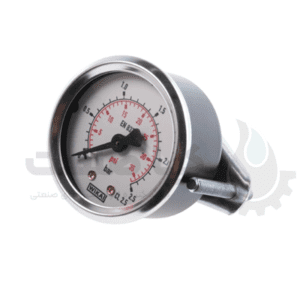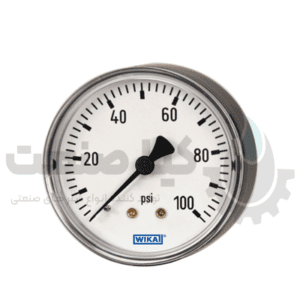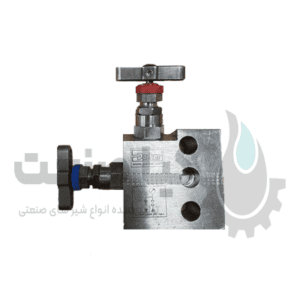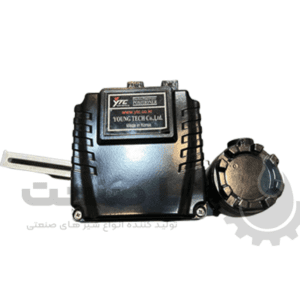Description
The magnetic level gauge is one of the accurate and reliable tools for measuring the level of liquids in tanks and industrial processes.
Using magnetic principles, this device provides accurate information about the level of liquids without the need for direct contact with the liquid.
In this article, we will discuss the expert review of the magnetic level gauge, how it works and its different types.
What is a magnetic level gauge?
Magnetic level gauge is a device that uses a magnetic float and a magnetic display to measure the level of liquids in tanks.
The magnetic float goes up and down with the change of the liquid level in the tank and creates a magnetic field.
This magnetic field is detected by the magnetic display located outside the tank and accurately shows the liquid level.
Types of magnetic gauges
- Magnetic level gauge with direct display
Structure and function: This type of gauge tube consists of a transparent glass or plastic tube that is installed next to the tank and a magnetic float that moves inside the tube.
The liquid level inside the transparent tube can be seen directly.
Applications: It is suitable for simple and directly visible applications of the liquid surface, such as small tanks in the food and beverage industries.
- Magnetic level gauge with magnetic strip display
Structure and function: This type of level gauge consists of a magnetic strip that is installed outside the tank and changes with the movement of the magnetic float inside the tank. These changes are displayed mechanically or electronically on the tape.
Applications: It is used in oil and gas, chemical and other industrial applications that require accurate measurement and are resistant to harsh environmental conditions.
- Magnetic level gauge with digital display
Structure and function: This type of level gauge uses advanced magnetic sensors to detect the position of the magnetic float and digital display of the liquid level.
The obtained information is displayed numerically or graphically on a digital display.
Applications: It is used in applications that require high accuracy and the ability to record and analyze data, such as pharmaceutical industries and complex chemical processes.
- Magnetic level gauge with analog or digital output
Structure and function: This type of level gauge can generate analog or digital signals and send them to control and monitoring systems. Magnetic sensors detect the position of the float and convert it into electrical signals.
Applications: In industrial automation and process control systems that require continuous communication with monitoring systems.
The structure and function of the magnetic level gauge
The magnetic gauge level consists of two main parts:
Magnetic float and magnetic display
The magnetic float is placed inside the tank and moves up and down as the liquid level changes.
This float contains a strong magnet that produces a magnetic field.
The magnetic display is located outside the tank and usually includes a graduated tape that displays the exact position of the float using magnets or magnetic sensors.
Advantages of using a magnetic level gauge
High accuracy: magnetic level gauges have the ability to provide very accurate measurements due to the use of strong and accurate magnetic fields.
Resistance to harsh environmental conditions: This type of level gauges can work well in harsh environmental conditions, including high temperatures, high pressure, and corrosive substances.
No direct contact with the liquid: because the magnetic display is outside the tank, the risk of damage and contamination is less.
Ease of installation and maintenance: Magnetic level gauges are easy to install and require less maintenance than other types of level gauges.
Applications of magnetic level gauge in different industries
1- Oil and gas industries
Storage tanks: Due to their high accuracy and resistance, magnetic level gauges are very suitable for measuring the level of crude oil and refined products in storage tanks.
Refineries: In oil and gas refineries, accurate control of liquid levels in reactors and process tanks is essential, and magnetic level gauges meet this need well.
2- Chemical industries
Corrosive and dangerous substances: In industries that work with corrosive and dangerous chemicals, magnetic gauges have a longer life and higher safety due to the lack of direct contact with the liquid.
Control of chemical processes: In chemical processes that require high accuracy in measuring liquid levels, these types of level gauges work well.
Water and sewage industries
Water storage tanks: To control the water level in storage tanks and ensure a stable supply of water, magnetic level gauges are very effective.
Treatment plants: In water and sewage treatment plants, magnetic level gauges are used for accurate level control and treatment processes.
Food and pharmaceutical industries
Production tanks: In the food and pharmaceutical industries that require high hygiene standards, magnetic level gauges are an ideal option due to their hygienic design and no contact with liquid.
Quality control: These level gauges help to maintain the quality of final products and prevent cross contamination.
Conclusion
Due to their high accuracy, resistance to harsh environmental conditions, and ease of installation and maintenance, magnetic level gauges are one of the best options for measuring liquid levels in various industries.
Using magnetic principles, these tools provide the possibility of accurate and reliable measurement, which is necessary to maintain the safety and efficiency of industrial processes.
The widespread use of magnetic level gauges in various industries shows the high efficiency of this tool in controlling and monitoring the level of liquids.
Kiasanat is a supplier of all kinds of level gauges with competitive prices. Contact our experts at Kiasanat for advice.









Reviews
There are no reviews yet.